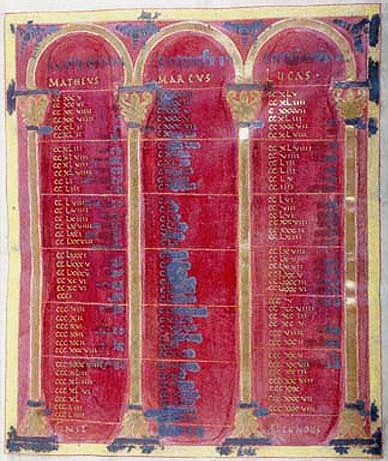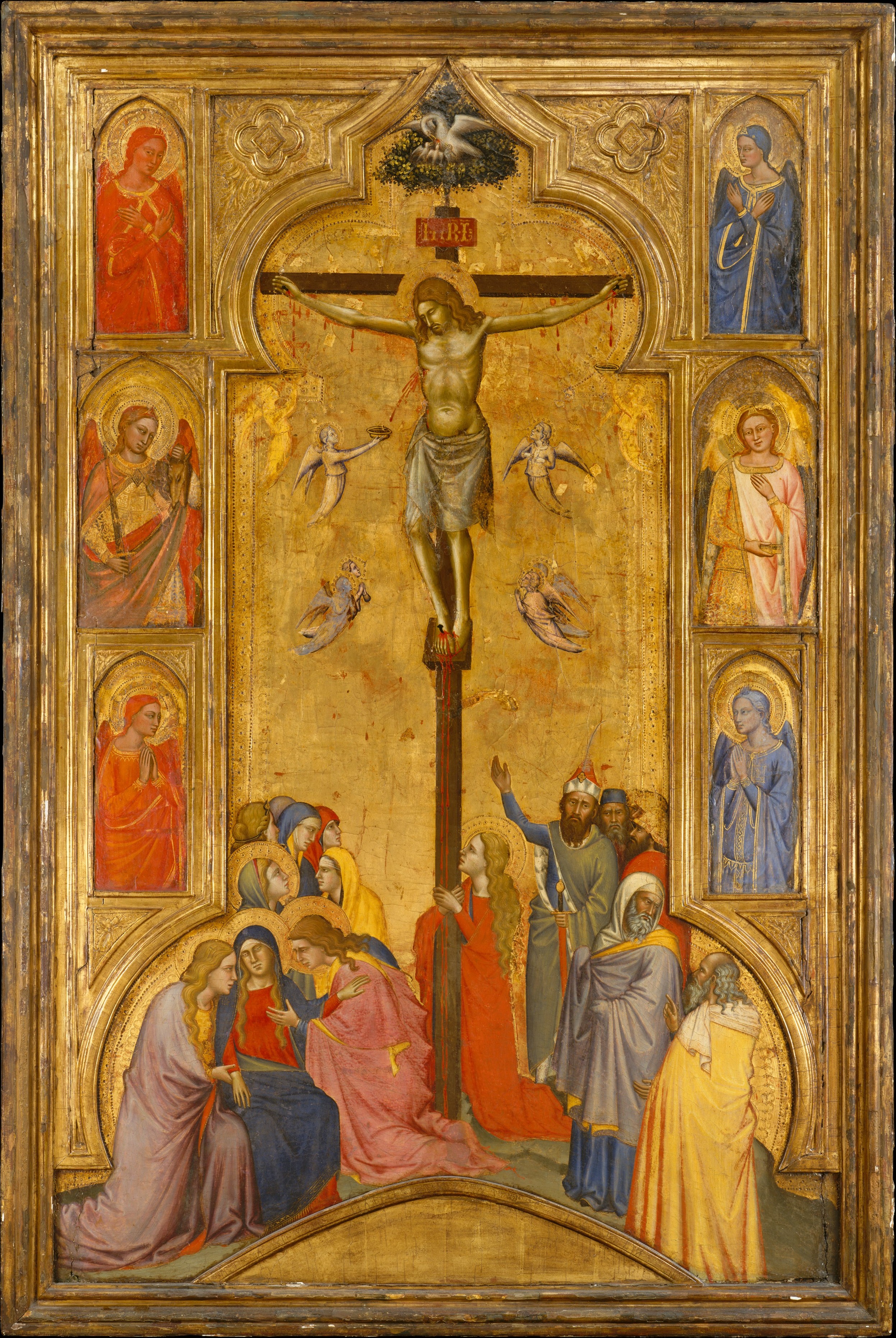|
Lindau Gospels
The Lindau Gospels is an illuminated manuscript in the Morgan Library in New York, which is important for its illuminated text, but still more so for its treasure binding, or metalwork covers, which are of different periods. The oldest element of the book is what is now the back cover, which was probably produced in the later 8th century in modern Austria, but in the context of missionary settlements from Britain or Ireland, as the style is that of the Insular art of the British Isles. The upper cover is late Carolingian work of about 880, and the text of the gospel book itself was written and decorated at the Abbey of Saint Gall around the same time, or slightly later. When J.P. Morgan, already in his early sixties, bought the book in 1901, it was his first major purchase of a medieval manuscript, setting the direction that much of his subsequent collecting was to follow.Needham, 24 Covers Lower cover The lower or back cover is older than the text and presumably added f ... [...More Info...] [...Related Items...] OR: [Wikipedia] [Google] [Baidu] |
Lindau Gospels, Jeweled Cover, France, Workshop Of Charles The Bald, C
Lindau (german: Lindau (Bodensee), ''Lindau am Bodensee''; ; Low Alemannic German, Low Alemannic: ''Lindou'') is a major Town#Germany, town and Lindau (island), island on the eastern side of Lake Constance (''Bodensee'' in German) in Bavaria, Germany. It is the capital of the county (''Landkreis'') of Lindau (district), Lindau, Bavaria and is near the borders of the Austrian state of Vorarlberg and the Switzerland, Swiss cantons of Canton of St. Gallen, St. Gallen and Canton of Thurgau, Thurgau. The coat of arms of Lindau town is a linden tree, referring to the supposed origin of the town's name (''Linde'' means linden tree in German). The historic town of Lindau is located on the island of the same name which is connected with the mainland by a road bridge and a railway dam leading to Lindau Hauptbahnhof, Lindau station. History The first use of the name Lindau was documented in 882 by a monk from St. Gallen, stating that Adalbert (Raetia, count of Raetia) had founded a nun ... [...More Info...] [...Related Items...] OR: [Wikipedia] [Google] [Baidu] |
Tassilo Chalice
The Tassilo Chalice (german: Tassilokelch; la, Calix Tassilonis) is a bronze chalice, gilded with silver and gold, dating from the 8th century AD. The chalice is of Anglo-Saxon design, and has probably been at Kremsmünster Abbey, Austria since shortly after it was made. History Dating from c. 770-790 AD, the chalice was donated by Liutperga, wife of the Bavarian Duke Tassilo III, possibly on the occasion of the establishment of the Benedictine Abbey at Kremsmünster in 777. The chalice is composed of an egg-shaped cup, a large knop (ornamental knob), and a relatively narrow foot (base). The chalice is cast in bronze that has been gilded with gold and silver and decorated by various methods, including niello engraving and chip-carving. It stands 25.5 cm high, and weighs 3.05 kg; its cup holds approximately 1.75 litres. The interlinked oval medallions round the cup show Christ (together with the initials "I" and "S", for ''Iesus Salvator'') and four Evangelist port ... [...More Info...] [...Related Items...] OR: [Wikipedia] [Google] [Baidu] |
Champlevé
Champlevé is an enamelling technique in the decorative arts, or an object made by that process, in which troughs or cells are carved, etched, die struck, or Casting (metalworking), cast into the surface of a metal object, and filled with vitreous enamel. The piece is then fired until the enamel fuses, and when cooled the surface of the object is polished. The uncarved portions of the original surface remain visible as a frame for the enamel designs; typically they are gilded in medieval work. The name comes from the French for "raised field", "field" meaning background, though the technique in practice lowers the area to be enamelled rather than raising the rest of the surface. The technique has been used since ancient times, though it is no longer among the most commonly used enamelling techniques. Champlevé is suited to the covering of relatively large areas, and to figurative images, although it was first prominently used in Celtic art for geometric designs. In Romanesq ... [...More Info...] [...Related Items...] OR: [Wikipedia] [Google] [Baidu] |
Gold Ground
Gold ground (both a noun and adjective) or gold-ground (adjective) is a term in art history for a style of images with all or most of the background in a solid gold colour. Historically, real gold leaf has normally been used, giving a luxurious appearance. The style has been used in several periods and places, but is especially associated with Byzantine and medieval art in mosaic, illuminated manuscripts and panel paintings, where it was for many centuries the dominant style for some types of images, such as icons. For three-dimensional objects, the term is gilded or gold-plated. Gold in mosaic began in Roman mosaics around the 1st century AD, and originally was used for details and had no particular religious connotation, but in Early Christian art it came to be regarded as very suitable for representing Christian religious figures, highlighting them against a plain but glistering background that might be read as representing heaven, or a less specific spiritual plane. Full- ... [...More Info...] [...Related Items...] OR: [Wikipedia] [Google] [Baidu] |
Agate Casket Of Oviedo
The Agate Casket of Oviedo ( es, Caja de las Ágatas, sometimes in English Agate Box, "Box of Agates") is an elaborately decorated box, casket or small chest given by King Fruela II of Asturias and his wife Nunila to the Cathedral of San Salvador, Oviedo, Spain. This masterpiece of 10th century Asturian gold work is kept in the Cámara Santa (Holy Chamber) treasury. Construction It is a rectangular box made of wood of European Pear, with a lid in the shape of a truncated pyramid. The Agate box is long, wide and high. The wooden box is covered with sheets of gold forming unequal arches in which 99 large flat sections of veined agate are mounted. The gold is decorated with cabochon gemstones and coral. The top of the lid is a gold plaque with a cross and three large gems which was taken from an older piece. It is decorated with small animals in enamel in a kind of champlevé technique that is only found in one other work, the South German rear cover of the Lindau Gospels, of ... [...More Info...] [...Related Items...] OR: [Wikipedia] [Google] [Baidu] |
Vitreous Enamel
Vitreous enamel, also called porcelain enamel, is a material made by fusing powdered glass to a substrate by firing, usually between . The powder melts, flows, and then hardens to a smooth, durable vitreous coating. The word comes from the Latin , meaning "glass". Enamel can be used on metal, glass, ceramics, stone, or any material that will withstand the fusing temperature. In technical terms fired enamelware is an integrated layered composite of glass and another material (or more glass). The term "enamel" is most often restricted to work on metal, which is the subject of this article. Essentially the same technique used with other bases is known by different terms: on glass as ''enamelled glass'', or "painted glass", and on pottery it is called ''overglaze decoration'', "overglaze enamels" or "enamelling". The craft is called "enamelling", the artists "enamellers" and the objects produced can be called "enamels". Enamelling is an old and widely adopted technology, for mo ... [...More Info...] [...Related Items...] OR: [Wikipedia] [Google] [Baidu] |
Cruciform Halo
A halo (from the Greek , ; also known as a nimbus, aureole, glory, or gloriole) is a crown of light rays, circle or disk of light that surrounds a person in art. It has been used in the iconography of many religions to indicate holy or sacred figures, and has at various periods also been used in images of rulers and heroes. In the religious art of Ancient Greece, Ancient Rome, Christianity, Hinduism, and Buddhism among other religions, sacred persons may be depicted with a halo in the form of a circular glow, or flames in Asian art, around the head or around the whole body—this last one is often called a mandorla. Halos may be shown as almost any colour or combination of colours, but are most often depicted as golden, yellow or white when representing light or red when representing flames. Ancient Mesopotamia Sumerian religious literature frequently speaks of (loaned into Akkadian as ), a "brilliant, visible glamour which is exuded by gods, heroes, sometimes by kings, an ... [...More Info...] [...Related Items...] OR: [Wikipedia] [Google] [Baidu] |
Interlace (visual Arts)
In the visual arts, interlace is a decorative element found in medieval art. In interlace, bands or portions of other motifs are looped, braided, and knotted in complex geometric patterns, often to fill a space. Interlacing is common in the Migration period art of Northern Europe, in the early medieval Insular art of Ireland and the British Isles, and Norse art of the Early Middle Ages, and in Islamic art. Intricate braided and interlaced patterns, called ''plaits'' in British usage, first appeared in late Roman art in various parts of Europe, in mosaic floors and other media. Coptic manuscripts and textiles of 5th- and 6th-century Christian Egypt are decorated with broad-strand ribbon interlace ornament bearing a "striking resemblance" to the earliest types of knotwork found in the Insular art manuscripts of Ireland and the British Isles.Mitchell et al. 1977, p. 59 History and application Northern Europe Interlace is a key feature of the "Style II" animal style decorati ... [...More Info...] [...Related Items...] OR: [Wikipedia] [Google] [Baidu] |
Chip Carving
Chip carving or chip-carving, ''kerbschnitt'' in German, is a style of carving in which knives or chisels are used to remove small chips of the material from a flat surface in a single piece. The style became important in Migration Period metalwork, mainly animal style jewellery, where the faceted surfaces created caught the light to give a glinting appearance. This was very probably a transfer to metalworking of a technique already used in woodcarving, but no wooden examples have survived. Famous Anglo-Saxon examples include the jewellery from Sutton Hoo and the Tassilo Chalice, though the style originated in mainland Europe. In later British and Irish metalwork, the same style was imitated using casting, which is often called imitation chip-carving, or sometimes just chip carving (authors are not always careful to distinguish the two), a term also sometimes applied to pottery decorated in a similar way. Woodwork In modern wood carving, the style is also called spoon carving. ... [...More Info...] [...Related Items...] OR: [Wikipedia] [Google] [Baidu] |



.jpeg/1200px-Gandhara_Buddha_(tnm).jpeg)
